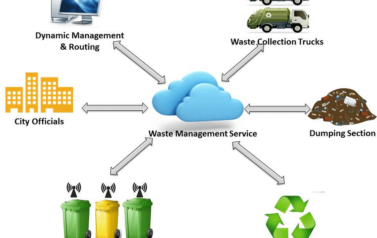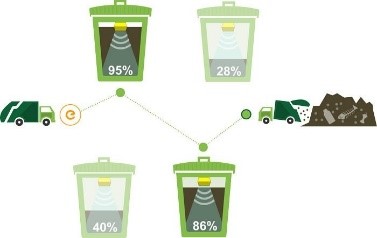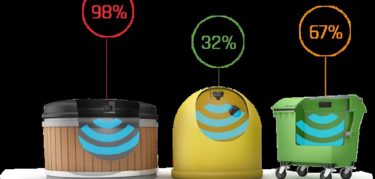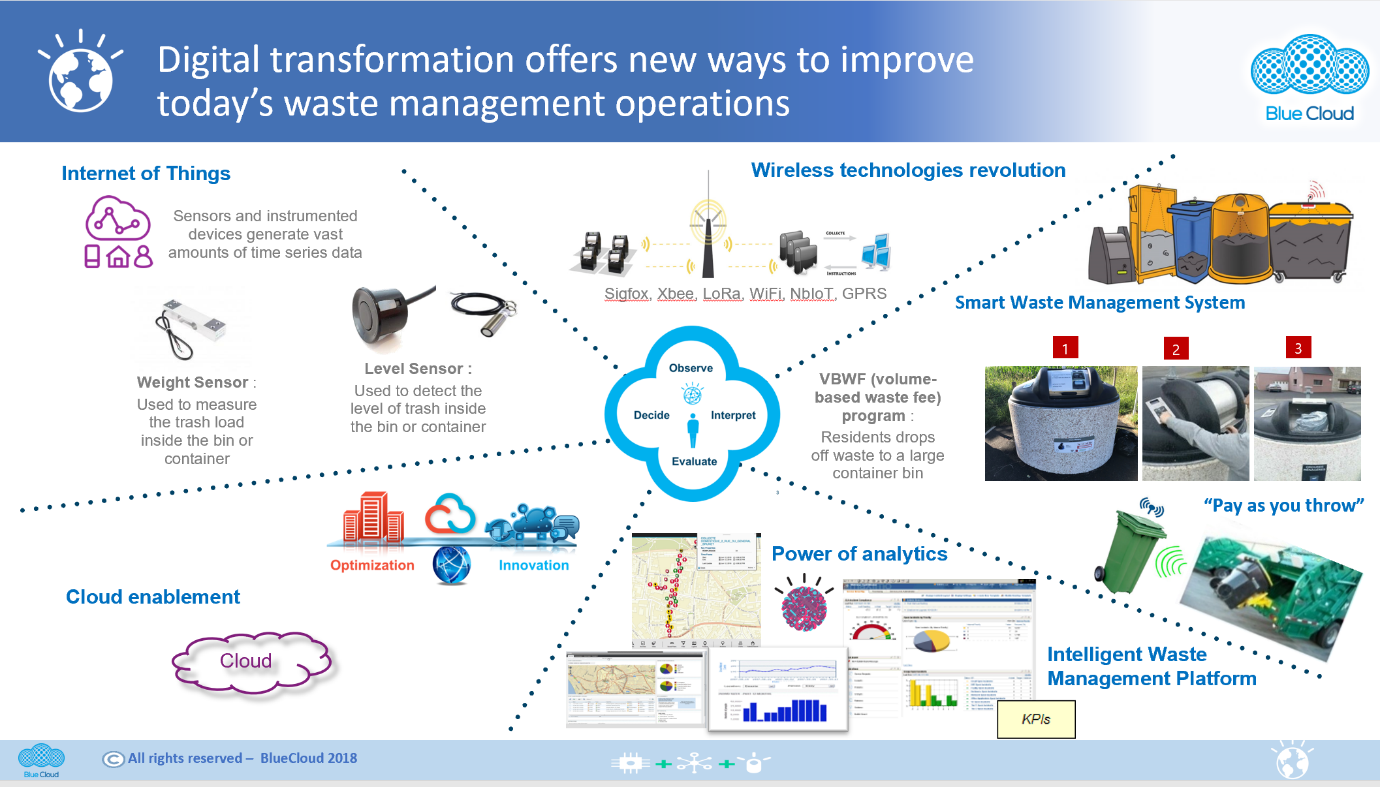Waste management

BlueCloud’s solutions for smart city players.
The digital solutions Smart Blue (including BlueWater for water cycle infrastructure , and BlueTrash for Waste Management), have been designed respectively :
- for elected officials and city managers to track the operation of their urban infrastructure and citizens’ perceptions,
- for technicians and infrastructure managers to help them manage them,
- for citizens and visitors to make their lives easier and involve them in the local circular economy.
Solid waste management is the one thing just about every city government provides for its residents. While service levels, environmental impacts and costs vary dramatically, solid waste management is arguably the most important municipal service and serves as a prerequisite for other municipal action.
Executive summary
Cities are becoming smarter, however, many lack sophistication and intelligence in key parts of their current infrastructure. Surging population growth and urbanization are not the only challenges city leaders face in delivering a suite of mandated public services, such as water, energy, transportation, public safety and healthcare.
This growth is also forcing them to deal with increasing amounts of garbage. The amount of garbage humans discard is quickly rising and will not peak this century without transformational changes in how we use and reuse materials.
By 2100, it is estimated that the growing global urban population will be producing three times as much waste as it does today. That level of waste carries serious consequences—physical and fiscal—for cities around the world.
Making improvements to a city’s solid waste management system is, in part, dependent upon other city systems characterized by BlueCloud and others as a “system of systems.” Transportation systems, smart infrastructures, intelligent operations and strategic asset management all contribute heavily to developing and operating smarter waste management alternatives, as well as cloud, analytics, mobile and social computing platforms.
Robust transportation networks, for example, are necessary for the efficient collection and transport of debris to material and energy recovery facilities, as well as landfills. Computing resources such as geographic information systems are valuable for planning collection routes, siting processing facilities, as well as for choosing locations for transfer stations, landfills and recycling facilities.
However, notwithstanding these dependencies, there is an opportunity today to deliver insight across the waste supply chain while improving a city or county’s discard profile, financial performance and environmental impact. The appropriate combination of technology, analytics and subject matter expertise can provide a solution with interactive stakeholder collaboration capabilities and improved operational insight and efficiency. With so much of our environment under significant stress in today’s world, Intelligent waste management is an area that can provide an immediate and significant impact to the environment and economy.
BlueCloud can help
The BlueTrash Intelligent Waste Management Platform provides rich visual analytics that quickly turn complex data sets and disparate information into high-value, actionable and innovative business opportunities. The insights delivered by this solution help to optimize operational performance, reduce processing costs, enhance revenue streams and provide the base for educational community outreach programs—the result being the foundation for a true circular economy. The BlueTrash Intelligent Waste Management Platform has powerful analytic tools designed to accommodate a variety of functional areas and roles across waste management services and government agencies. It allows users to quickly and automatically collate waste collection, financial and demographic information, as well as other non-waste management data such as weather, traffic and population variance. All of this vital but disparate information can be presented in an easily understandable visual analytics environment.
Solution overview

The BlueTrash Intelligent Waste Management Platform can help identify insights ranging from cities trying to increase diversion and reduce waste management costs to material recovery facility operators trying to maximize profits as part of an overarching circular economy approach.
How the solution works
Flexible data acquisition and integrity validation The BlueTrash Intelligent Waste Management Platform allows users to quickly and automatically import a wide range of waste management data using their own terminology and hierarchy. In addition, the platform provides many automated data integrity-checking features—all of which are important when importing discard data, as it is often transcribed manually.
Examples of the types of waste management data the solution can accept include:


- Route frequency and details, such as customer and bin locations
- Container details including size, type, ID tags, and sharing percentages
- Scale weights for either a bin or a truck
- Demographics such as income, age and building type
- Process methods
- Waste characterization details
- Various financial data, such as tipping fees, material value, income data, haul fees and rental fees
- User-defined non-waste data such as precipitation and population density

Every organization has a different quality and quantity of data. The BlueTrash Intelligent Waste Management Platform allows the user to begin the analysis with whatever they have available today. They can expand the variety and volume of data over time, as needed, to perform more specific analyses.
Powerful analysis capabilities
The BlueTrash Intelligent Waste Management Platform provides a wide range of analysis and visualization capabilities in a single environment to help the user better understand complex data sets in order to:
- Compare actual vs. expected results on a wide range of waste management data ranging from levels/weights to waste characterization to financial data.
- Identify gaps where information may have not been reported.
- Assess if overall and site-based waste diversion goals are being met through the use of key performance indicators.
- Identify non-obvious connections and trends.
The analysis and visualization tools include:
- Administrator overview allows an overall understanding of the waste management financial data, set out rate or weight status, as well as key performance indicators with the status of waste diversion goals.
- Interactive analysis and reporting tools highlight trends in financials, level/weight and set out rates across the wide variety of data, providing real-time interactive filtering capabilities and trend analyses.
- Supply chain analytics allow drill downs into discard details comparing expected vs. forecasted collection levels/weights and waste characterization (if the data is available). The user can also overlay other data to understand correlations that might not otherwise be apparent.
- Outreach portal provides a customer or the public access to a portal to understand their current waste management status.
Sample use cases

The following examples show how the BlueTrash Intelligent Waste Management Platform provides easy access for analyzing complex data sets, helping an organization make better business decisions.
Feel free to contact BlueCloud, if you have any questions or would like further information. www.blue-cloud.fr



